Letters from Lodi
An insightful and objective look at viticulture and winemaking from the Lodi
Appellation and the growers and vintners behind these crafts. Told from the
perspective of multi-award winning wine journalist, Randy Caparoso.
Putting all this wine geeky talk about “balance” to bed (once and for all!)
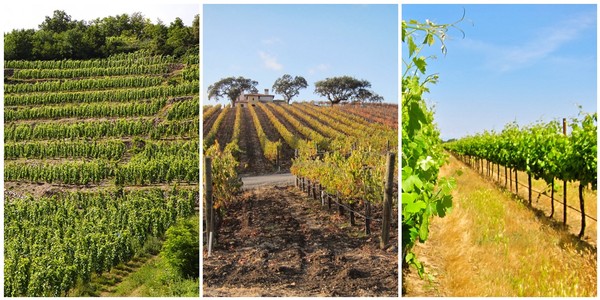
Three appellations where the Syrah grape is grown, producing wines of distinctively different alcohol levels, fruit profiles, and sense of balance due purely to widely varying growing conditions: (from left), Cornas in the Northern Rhône Valley, and California's Ballard Canyon (Santa Barbara) and Mokelumne River-Lodi AVAs.
On the face of it, talking about wines being "balanced" was always perfectly okay. That is, until about ten years ago, when the term suddenly became politicized, like vaccines, gender identities, or anything suggesting "natural." People started taking sides, and somewhere along the line, the notion popped up that wines over 14% alcohol, or pick “overripe,” are somehow inferior or less “balanced” than wines picked at lower sugars, and finished closer to 12% or 13% alcohol (i.e., ABV, or "alcohol by Volume").
This is in spite of the fact that the vast majority of mainstream American varietal wines, like Chardonnay, Cabernet Sauvignon, Pinot Noir, and Merlot, are now over 14% alcohol. The choice of wines to drink, after all, has always been an aesthetic one; and aesthetically, most American wines are now like this because it is the preference of the overwhelming number of consumers. People like full-bodied, richly fruited wines. If they preferred, say, light, lean, and tart wines, most wines would be made like that.
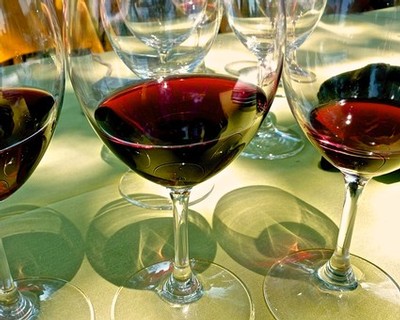
Glasses of Santa Lucia Highlands Pinot Noirs are considered some of the finest in the world, yet typically finished at 14.5% to 15% alcohol.
Consumers, when you think about it, make their choices in the same way they choose to listen to Justin Bieber rather than Beethoven or Duke Ellington or to read Harry Potter instead of Ulysses or The Corrections. The other day, my 4-year-old granddaughter was asked by her aunt if she'd like to listen to a Beatles record. She said, "No thank you, I prefer the Stones." In matters of taste, it's all good.
The whole point of systems like France’s AOC (i.e., appellation d'origine contrôlée), for example, is to delineate the best wine-growing regions. But not to say which regions are "best." Which is why it is no more valid to say a Côte-Rôtie is superior to a Cornas or Saint-Joseph — appellations that all produce red wines from the Syrah grape — than it is to say a Saint-Joseph is better than a Mollydooker South Australia Shiraz, or that a Mollydooker out-dukes a Stolpman Syrah from Santa Barbara or Klinker Bricks from Lodi. It’s a silly argument because different regions produce wines of different terroir-related distinctions, often at extraordinary levels of quality that transcend arbitrary conceptions like alcohol, perceptions of “ripeness,” or even a sense of “balance.” One man's ceiling, as they say, is another man's floor.
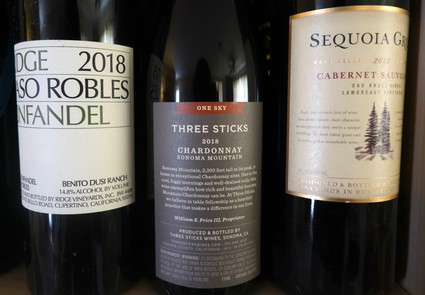
Alcohol levels of typical California wines: (from left), a Paso Robles Zinfandel (14.8% ABV), Sonoma Mountain Chardonnay (14.2% ABV), and Napa Valley Cabernet Sauvignon (14.8% ABV).
Charles Olken, who has been publishing Connoisseurs’ Guide to California Wine since the days when French judges regularly mistook wines like Chateau Montelena Chardonnay for Montrachet, once put things in perspective for me by sharing this thought: “Every new generation of wine commentators suddenly discovers that California wines are a little bit riper than their European counterparts. A few of them genuinely like the part, tighter, high acids they find in Europe, but others simply adopt Europe as a ‘classic’ and thus dismiss all that is different.”
Olken shared those thoughts with me back in 2012, right around the time that the loose-knit yet much-discussed movement called "In Pursuit of Balance" had reached an apogee. Olken added, about those times, “If someone pointed out that balanced wines do, in fact, exist at levels above 14%, that person was branded a ‘high alcohol apologist’ by people who should know better, and who themselves often recommend wines as high as 15% based upon their own blind tastings.”
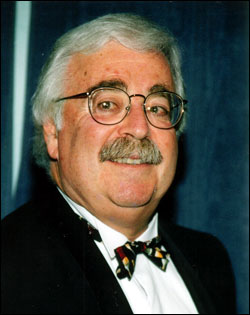
Charles Olken has been publishing the widely followed Connoisseurs' Guide to California Wine since 1974.
It wasn’t so much what commonly happens in blind tastings. It’s more a case of people putting on blinders, than bragging about it. Who can ever forget, as it were, the incident at the 2011 World of Pinot Noir, during a panel tasting, when Siduri winemaker/owner Adam Lee switched a 15.2% ABV Pinot Noir with a 13.6% ABV Pinot Noir — resulting in the higher alcohol wine being described as “better balanced” by a fellow panelist, who happened to be one of the higher-profile proponents of In Pursuit of Balance. Blind tastings make fools of us all.
What is harder to understand is why even experienced wine professionals who should know better cannot reconcile with this simple, incontrovertible fact: That sensory perception is always altered by scale and context, no matter what your avowed preferences or intellectual persuasions. Quite often a 15.2% ABV Pinot Noir does indeed taste much finer, and better balanced, than a 13.6% ABV Pinot Noir, and it has nothing to do with alcohol. The best wines are so much more than just one technical component.
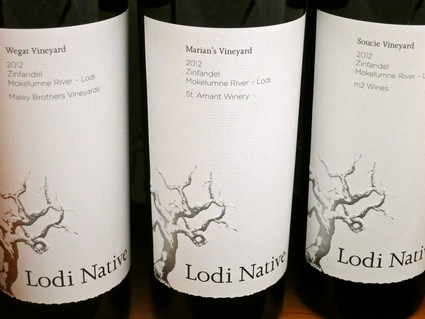
Lodi Native bottles — natural yeast fermented Zinfandels representing the lightest, most elegant styles grown in Lodi, yet averaging 14.0% to 14.5% ABV.
I, for one, have always preferred a lighter, more gentle, finesse style of Pinot Noir. Line up any two Pinots, and I’ll always pick the more restrained, sharper style over the big, “opulent” or “hedonistic” one. But that's a personal predilection. Yet I’ll never forget another World of Pinot Noir event when I tasted a stunning wine that I thought was one particular winemaker’s finest Pinot Noir ever. Afterward, I wrote to him, gushing about my enthusiasm.
His response? “This was probably our most difficult Pinot noir to make... we experienced a sudden late-season heat spike, and grape sugars soared out of control... the alcohol ended up over 15%.” Needless to say, I hadn’t checked the alcohol content on the label. Does this make me a lousy judge of Pinot? No. It just means it was a damned good wine — very much a product of its vintage, Mother Nature's whims, a credit to its source (Sta. Rita Hills), and the savviness of its winemaker.

At a past Lodi ZinFest, faces of California wine lovers — the ultimate arbiters of what constitutes appealingly "balanced" wines.
Still, I can’t help but think: All that talk about "balance" smacked of a self-indulgent conceit. Like living in a nanny state of wine. These days it's called "cancel culture." What's embarrassing, looking back, is the fact that at one point there was one segment of the wine industry that was actually trying to cancel out the types of wines most consumers clearly prefer — that is full-bodied, generously fruited wines.
That didn't stop a few retailers, and a good number of sommeliers, from jumping on the In Pursuit of Balance bandwagon, making a point of rejecting wines above 14% alcohol and embracing leaner alcohol wines whether they were appealing or not. No wonder so many folks still wince at the sight of sommeliers. Especially since all consumers really want out of sommeliers is a good wine list, and an occasional recommendation — preferably something in synch with their taste. No one needs nannying.
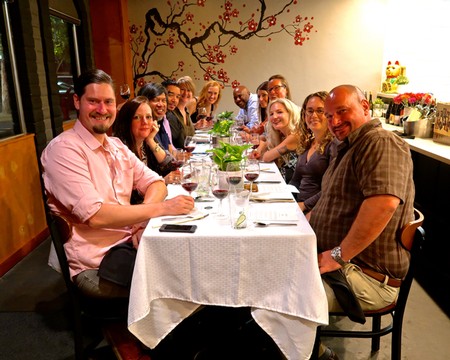
Visiting sommeliers enjoying Lodi wines at Lodi's M Sushi Bistro.
Ultimately, though, a sommelier's mission is to steer a guest towards the ideal wines for dishes, regardless of alcohol levels, because the better a wine tastes with a dish the better the impression of a restaurant. And this is where the democracy of wines comes in. It doesn't matter, for instance, if a Côte-Rôtie is better (or better "balanced") than a Cornas or Saint Joseph. What matters more is if one of these red Rhônes goes with the food a customer happens to order, like grilled or roasted red meat; or, as the expatriate food writer Richard Olney once famously prescribed, with a braised and stuffed shoulder of lamb.
But take those same grills or braises and finish them with reductions of fruit or in a Port-infused demi-glace, plus beds of onion marmalade or caramelized root vegetables, and I’d wager that a humongous Australian Shiraz might actually fare better than the leaner, earthier wines of the Northern Rhône. Incorporate exotic ingredients like star anise, hoisin, black beans, or chocolate mole, and then lavish, sweet-toned, decidedly warmer climate American Syrahs from, say, Lodi, Santa Barbara's Ballard Canyon AVA, or Southern Oregon might make even more sense. If some dishes are better off matched with fruitier, higher alcohol, lower acid Syrahs, so be it.
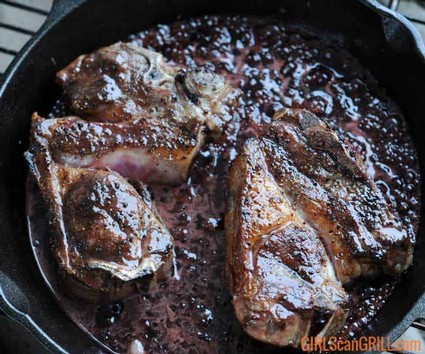
Shoulder of lamb finished in a sweet fruit-toned Port and cherry preserve-infused demi-glace; a dish more likely to be complemented by a fuller-bodied, ripe fruit style of Australian or California Syrah than a leaner style from France's Northern Rhône Valley. girlscangrill.com.
Eventually, of course, In Pursuit of Balance is a movement puttered out on its own. Not with a bang but a whimper. We're back to living in a world where we taste a wine first, before peering at a label to see if it finished at 12.5% or 15.5% alcohol. Either way, it's okay if it tastes great. Which was always the way it was supposed to be.
This is especially good because there's too much good winegrowing going on out there to dismiss anything because of arbitrary standards like alcohol level, or someone's conception of varietal character. "Balance," as a wine term, is back to being a descriptor, not the name of a cause, or code for lean and under-fruited.
The most important thing is getting back to judging wines for what they are, not for what anyone says they're supposed to be. The appreciation, that is, of the sheer diversity coming out of all the regions and terroirs around the world. Or as the French have been correctly saying all along, Vive la différence!
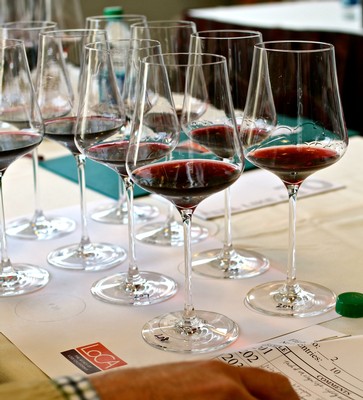
Blind tasting of Lodi Zinfandels.